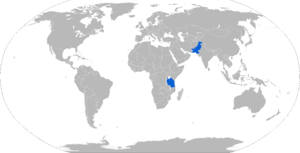A-100 MRL
The A-100 is a 300 mm, 10-tube multiple rocket launcher developed by Beijing-based China Academy of Launch Vehicle Technology (CALT, also known as 1st Space Academy) for the Chinese PLA ground forces. It is a derivative of Weishi Rockets WS-1 with simple cascade terminal inertial guidance.[1]
| A-100 | |
|---|---|
| Type | Multiple rocket launcher |
| Place of origin | China |
| Service history | |
| In service | 2000-present |
| Production history | |
| Designer | China Academy of Launch Vehicle Technology |
| Designed | 1997-2000 |
| Specifications | |
| Mass | 45 t |
| Length | 9 m (29 ft 6 in) |
| Width | 2.8 m (9 ft) |
| Height | 3.2 m (10 ft) |
| Crew | 4 |
| Caliber | 300 mm (12 in) |
| Barrels | 10 |
| Maximum firing range | 100 km (62 mi) |
Main armament | Rockets |
| Engine | diesel 640 hp (480 kW) |
| Suspension | 8×8 wheeled |
Operational range | 650 km (400 mi) |
| Maximum speed | 60 km/h (37 mph) |
Overview
China reportedly received a small number of the Russian Smerch 9K58 300 mm, 12-tube multiple launch rocket system and its ammunition in 1997. The Smerch 9K58 system is capable of firing a ‘smart’ submunition that has a dual-colour infrared sensors for terminal guidance, which enables the rocket to achieve accuracies previously difficult to achieve with unguided rockets of that range. The submunition is fitted with kinetic energy fragment warheads which are said to be able to penetrate 70mm of armour at an angle of 30° to the normal.
China National Precision Machinery Import and Export Corporation (CPMIEC), a trading company that markets Chinese missile and defence technologies to foreign customers, revealed the A-100 multiple launch rocket system in 2000. The system was developed by CALT, which is famous for its ChangZheng (Long March) family of space launch vehicles and DongFeng family of ballistic missiles. The A-100 system is CALT's first attempt to break into the tactical weapons market. The development of the A-100 possibly began in the late 1990s and the MRL system was observed in service with the PLA 1st Artillery Division in Guangzhou MR in 2002, possibly for trial and evaluations.
Although the system resembles the Russian Smerch 9K58 300 mm rocket system, it is not a copy of the Smerch as previously speculated. The A-100 rocket is fitted with a simple guidance system for greater accuracy.
In 2019, Pakistan's inter service public relations released an official statement regarding the indigenously developed A-100 and its induction as part of its Multiple Launch Rocket System of the artillery corps.[2]
Rocket specifications
- Rocket calibre: 300mm
- Rocket length: 7,300mm
- Rocket weight: 840 kg
- Warhead: 235 kg, ~500 submunitions
- Firing range: 40~100 km
The A-100 fires 300 mm solid propellant rockets, with a firing range of 40~100 km. The A-100 rocket is 7.3m in length, weighs 840 kg, carries a 235 kg warhead, and is stabilised by spin, thrust, and stabilising fins. It is fitted with a warhead containing 500 HE-FRAG (High Explosive Fragmentation) anti-armour/personnel submunitions. The submunition can penetrate 50mm of armour, and has a blast radius of 7m. The submunitions have a spreading radius of 100 +/- 40 metres.
The rocket consists of the warhead and fuse, a thrust stabilising system, a rocket motor and the tail section. The rocket motor is a single chamber, solid rocket motor with an advanced hydroxy-terminated polybutadiene (HTPB) composition rocket propellant. The stabilising fins are folded inside the launch tube and open once the rocket leaves the tube.
The rocket is equipped with an onboard computer to help correct the horizontal and vertical deviations. During the first three seconds of the rocket's flight, the onboard computer detects the horizontal difference between the programmed trajectory and actual status of the rocket, and controls the rocket's stabilising thrust system to correct the rocket's flying direction. The onboard computer corrects the vertical deviation by adjusting the warhead detonation time so that the submunitions are spread with high accuracy.
Launch vehicle
- Launch vehicle road speed: 60 km/h
- Launch vehicle travelling range: 650 km
- Reloading time: 20 minutes
The launch vehicle is based on a TAS5380 8X8 wheeled truck chassis developed by Tai'an Special Vehicle Manufactory. The vehicle weights 21t and has a maximum load of 22t. The vehicle has a maximum road speed of 60 km/h and a maximum range of 650 km. The vehicles has a gradient of 57% and a fording depth of 1.1m. The vehicle is equipped with four hydraulically operated stabilisers which are lowered in preparation for the rocket launch. 10 launcher tubes mounted on the chassis are arranged as two blocks of four (top) and six (bottom) tubes.
Variants
A200
Development of A100 with simple cascade inertial terminal guidance updated by GPS. The arrangement of A200 is different from A100 in that each launching box consists of three rows of launching tubes, three on the top and bottom respectively, and two in the middle. A200 rockets also have additional forward control surfaces that were not present on A100 rockets.[3]
Operators

Current operators


Failed trials

See also
References
- A100 MRL
- https://www.dawn.com/news/1455467
- 国产A200远程制导火箭武器射程200公里火力猛 (in Chinese). 19 November 2010. Retrieved 29 November 2017.
- "Archived copy". Archived from the original on 5 March 2016. Retrieved 3 February 2018.CS1 maint: archived copy as title (link)
- "Chinese army will purchase A300 MLRS Multiple Launch Rocket System using GPS guidance". 1 April 2015. Retrieved 29 November 2017.
- "A-100 Multiple launch rocket system". military-today.com. Retrieved 21 September 2013.
- "Tanzania importing Chinese MLRS". Kanwa Daily News. Archived from the original on 25 September 2013. Retrieved 21 September 2013.
- Jane's Land Based Air Defence 2005-2006
- "A-100 300MM MULTIPLE LAUNCH ROCKET SYSTEM". Archived from the original on 13 February 2008. Retrieved 5 February 2008.
